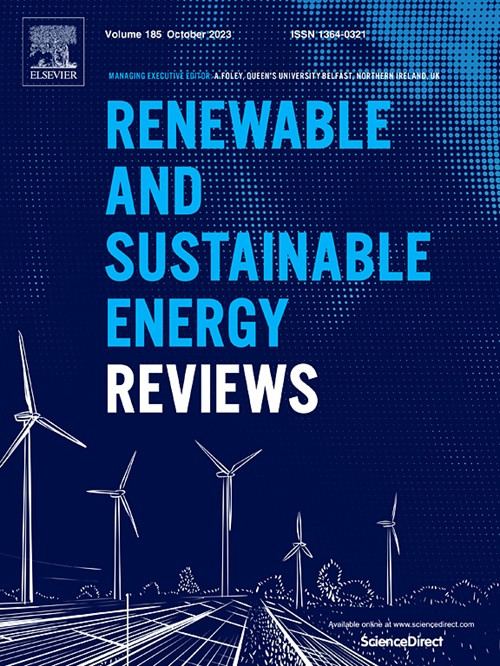Decarbonisation strategies for critical mineral supply chain: State-of-Art in mining and refining industries
IF 16.3
1区 工程技术
Q1 ENERGY & FUELS
引用次数: 0
Abstract
Despite their vulnerability to climate change, mining and refining industries significantly provide energy transition materials. However, if no mitigation is implemented, the demand growth will increase direct and indirect emissions in the critical mineral sector. This research aims to comprehensively evaluate the decarbonisation agenda in lithium, nickel, and cobalt industries by profoundly examining the performances, strategies, and risks associated with climate transition. This study examines company reports of 27 players that accounted for at least half of the global lithium, nickel, and cobalt production. This study uses content analysis methodology to reveal patterns in decarbonisation targets, performances and practices. More than two-thirds of the observed companies favour onsite solar and wind generation. At least one-third of the samples mention energy-efficient equipment and electric vehicle adoption. Despite having a well-crafted strategy to reduce operational emissions, more efforts are needed to reduce the value-chain emissions. This study highlights the need for improvement in the carbon inventory and disclosure of scope three emissions by utilising artificial intelligence and maintaining strategic partnerships with stakeholders. Political, economic, social, technological, legal, and environmental (PESTLE) analysis also revealed patterns and linkages among the current decarbonisation challenges and opportunities, of which the industries are vulnerable to demand fluctuation, rising from regulatory and technological changes. This study highlights the current dynamics in the critical mineral supply chain, which may affect decarbonisation strategies in the industry. This study also provides a holistic approach to offer empirical practice for the industries, allowing them to tailor their strategies.
关键矿产供应链的脱碳战略:采矿和炼油行业的最新技术
尽管矿业和炼油行业易受气候变化的影响,但它们为能源转型提供了大量材料。然而,如果不采取缓解措施,需求增长将增加关键矿产部门的直接和间接排放。本研究旨在通过深入研究与气候转型相关的绩效、策略和风险,全面评估锂、镍和钴行业的脱碳议程。本研究调查了27家公司的报告,这些公司至少占全球锂、镍和钴产量的一半。本研究使用内容分析方法来揭示脱碳目标、绩效和实践的模式。在被调查的公司中,超过三分之二的公司倾向于在现场进行太阳能和风能发电。至少三分之一的样本提到了节能设备和电动汽车的采用。尽管有一个精心设计的战略来减少运营排放,但需要更多的努力来减少价值链的排放。本研究强调了通过利用人工智能和与利益相关者保持战略合作伙伴关系,改进碳清单和披露第三类排放的必要性。政治、经济、社会、技术、法律和环境(PESTLE)分析还揭示了当前脱碳挑战和机遇之间的模式和联系,其中行业容易受到监管和技术变革引起的需求波动的影响。本研究强调了关键矿产供应链的当前动态,这可能会影响该行业的脱碳战略。本研究也提供了一个整体的方法,为行业提供实证实践,使他们能够定制他们的战略。
本文章由计算机程序翻译,如有差异,请以英文原文为准。
求助全文
约1分钟内获得全文
求助全文
来源期刊

Renewable and Sustainable Energy Reviews
工程技术-能源与燃料
CiteScore
31.20
自引率
5.70%
发文量
1055
审稿时长
62 days
期刊介绍:
The mission of Renewable and Sustainable Energy Reviews is to disseminate the most compelling and pertinent critical insights in renewable and sustainable energy, fostering collaboration among the research community, private sector, and policy and decision makers. The journal aims to exchange challenges, solutions, innovative concepts, and technologies, contributing to sustainable development, the transition to a low-carbon future, and the attainment of emissions targets outlined by the United Nations Framework Convention on Climate Change.
Renewable and Sustainable Energy Reviews publishes a diverse range of content, including review papers, original research, case studies, and analyses of new technologies, all featuring a substantial review component such as critique, comparison, or analysis. Introducing a distinctive paper type, Expert Insights, the journal presents commissioned mini-reviews authored by field leaders, addressing topics of significant interest. Case studies undergo consideration only if they showcase the work's applicability to other regions or contribute valuable insights to the broader field of renewable and sustainable energy. Notably, a bibliographic or literature review lacking critical analysis is deemed unsuitable for publication.
 求助内容:
求助内容: 应助结果提醒方式:
应助结果提醒方式:


